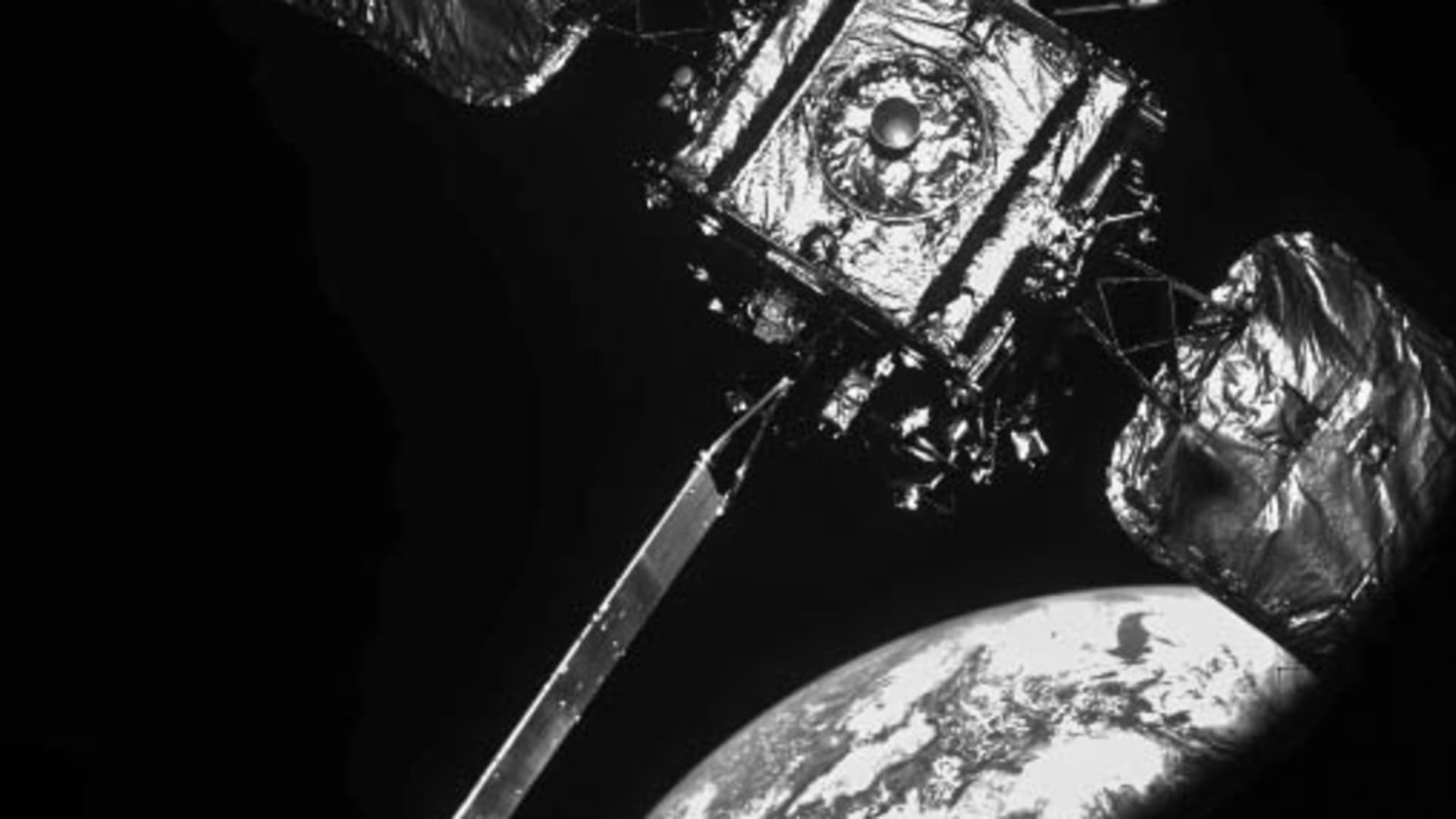In an artist’s rendition, an MRV approaches a commercial satellite for MEP installation.
Northrop Grumman, SpaceLogistics
CNBC’s Investing in Space newsletter offers a view into the business of space exploration and privatization, delivered straight to your inbox. CNBC’s Michael Sheetz reports and curates the latest news, investor updates and exclusive interviews on the most important companies reaching new heights. Sign up to receive future editions.
Overview: Time for a satellite tune up
It may be time to service your satellite.
A division within Northrop Grumman has in recent years become the world leader in extending the life of valuable satellites that are already in orbit. Like any tune-up, it involves a mechanic, but this one’s robotic and performing a delicate dance far above Earth.
The company is building further on that business model. But how big is the market for satellite servicing, really, in an age where spacecraft are built and launched more cheaply and frequently than ever before?
I chatted this week with Jean-Luc Froeliger, senior vice president of space systems at Intelsat, whose company announced an order from Northrop Grumman’s Space Logistics unit for its latest service technology iteration.
A quick step back: In 2020, Northrop Grumman’s robotic spacecraft MEV-1 successfully docked with an old Intelsat satellite and extended its life by five years, marking an industry first. A year later, the companies took that feat a step further, docking MEV-2 with an active Intelsat satellite.
A close up look at Intelsat’s IS-10-02 satellite as MEV-2 approached for docking in orbit.
Intelsat
Northrop Grumman’s latest version of this tech represents a more flexible approach: A larger model, called MRV (or mission robotic vehicle), will carry three MEPs (or mission extension pods), that it plans to deliver and connect with three satellites in 2026. Like before, the targets are big, expensive satellites operating in the distant geosynchronous orbit.
Intelsat ordered one of the MEPs, as did Australian satellite operator Optus. A third is expected to be sold soon.
An artist’s rendering of the Mission Robotic Vehicle with a Mission Extension Pod.
Northrop Grumman, Space Logistics
Froeliger explained that the new approach represents a shift in business strategy for Intelsat from “renting” the MEVs for a certain number of years to owning.
“In the end, it’s all a business decision that depends on the price of the MEP versus the price of a yearly MEV service,” Froeliger said.
While Intelsat has “study contracts with three or four other companies” for future satellite servicing missions, Froeliger noted that Northrop Grumman is the most “advanced” in this space sub-sector.
But the size of the market today largely depends on the number of geosynchronous satellites that would benefit from life extension. Froeliger said about 10% of the 56 satellites in Intelsat’s fleet are candidates – making satellite servicing still a niche market.
“The others we’ll replace with a brand new satellite,” Froeliger said.
What’s up
- SpaceX nears first Starship orbital launch: The company announced that the first flight to space of the towering rocket “is trending towards the third week of April,” with a potential launch as early as Monday. That depends on regulatory approval from the FAA, but the company could reportedly receive its launch license in the next day or so. – SpaceX / Ars Technica
- Relativity retires Terran 1 to go ‘all in’ on Terran R development, in a substantial shift in the company’s 3D-printing-first strategy that includes introducing more traditional manufacturing methods into building the rockets. Relativity revealed a substantial update on Terran R’s design, with a focus on making the first stage reusable rather than the entire rocket. – CNBC
- SpaceX launches 23rd mission of the year carrying Intelsat satellite, IS-402, successfully into orbit on a Falcon 9 rocket. Its booster landed successfully for a fourth time. – Intelsat
- FCC debuts Space Bureau as the regulator looks to centralize its management of satellite policy and licensing under a single office. – FCC
- Rocket Lab shifts NASA satellite launches to New Zealand from Virginia, in order to make sure its Electron rockets can deliver the TROPICS satellites into orbit in time to help provide data for this year’s hurricane season. – Rocket Lab
- Planet expands data products, deploying a pair of new programs “focused on increasing accessibility and scaling solutions for users.” In an expansion of its “Planetary Variables” product, the company is making more available data feeds such as “Roads and Building Detection” and “Soil Water Content.” – Planet
- Viasat connects ground antennas into Microsoft’s Azure Orbital cloud network, saying the addition of the five different locations around the world will improve “high-speed connectivity” with Microsoft’s platform. – Viasat
- Microsoft, Ball and Loft to work on SDA’s NExT satellite program, which will fly 10 satellites with experimental payloads for the Space Development Agency. – Ball Aerospace
- Slingshot expands tracking capabilities with plans for a network for “more than 200 sensors across more than 20 sites globally” to track objects in low Earth orbit. – Slingshot Aerospace
- SpaceX senior director talks about how its Dragon spacecraft experience prepares the company for Starship: Stuart Keech, senior director of Dragon Engineering, said the company is taking “the lessons learned and the best parts of both” its Falcon 9 rocket and Dragon capsule to make Starship “an ultimately better and more capable vehicle.” – Supercluster
Industry maneuvers
- Canadian satellite communications startup Kepler raises $92 million, in a round led by IA Ventures. The company has raised over $200 million to date, from investors including Costanoa Ventures, Canaan Partners, Tribe Capital and BDC Capital’s Industrial Innovation Venture Fund. – Kepler Communications
- Euroconsult finds 2.6 billion people remain unconnected by broadband services, with an analysis finding a “significant” opportunity for service providers to build on the $74 billion market in the decade ahead. – Euroconsult
- European quarterly investment in space outstripped the US for the first time, according to U.K.-based firm Seraphim’s Q1 report. Per the firm’s findings, Q1 saw $565 million in space investment in Europe, versus $456 million in the U.S. – Seraphim
- Raytheon partners with SpiderOak to enhance satellite cybersecurity, with the strategic one-year collaboration centered around developing “a new generation of zero-trust security systems.” – Raytheon
- Inmarsat partners with Taiwanese chipmaker MediaTek in three year agreement to develop technologies for the satellite direct-to-device market. – SpaceNews
Boldly going
- K. Guru Gowrappan named Viasat President, joining the satellite operator from his previous role as CEO of Verizon Media Group, the media division of Verizon Communications. – Viasat
- Molly Carter hired as director of sales and marketing at COMSPOC, the space situational awareness company. Carter previously was head of business development and operations strategy for Avalara Corporation. – COMSPOC
- Space Florida begins search for new president and CEO: Following Frank DiBello’s retirements, the state authority is looking “nationwide” for a new leader to manage its economic development portfolio. – SpaceFlorida
Market movers
- Nasdaq suspends Virgin Orbit stock trading: As the now bankrupt rocket builder begins an auction process, Nasdaq announced public trading of the company’s shares would be suspended on April 13, with the exchange also looking to delist the stock. Virgin Orbit is looking to conduct an expedited sale in bankruptcy court, seeking to begin a bidding process in early May. – Virgin Orbit / SpaceNews
- Astra gets 6-month Nasdaq listing extension, avoiding a potential delisting as the company works to keep its stock publicly traded and turn around its business. – Astra
- Astra issues notices to unnamed broker-deals over ‘potential illegal short selling’ in the company’s stock, saying its investigation with ShareIntel found “trade imbalances” that “deeply concerned” the company that it was “the target of a market manipulation scheme.” – Astra
On the horizon
- Apr. 14: Arianespace’s Ariane 5 launches JUICE spacecraft from French Guiana.
- Apr. 17-20: Space Symposium conference in Colorado.
- Apr. 17: SpaceX’s Starship launches first orbital attempt from Texas, pending final readiness and regulatory approval.
- Apr. 18: SpaceX’s Falcon Heavy launches ViaSat 3 and Astranis satellites from Florida.
- Apr. 19: SpaceX’s Falcon 9 launches Starlink mission from Florida.


